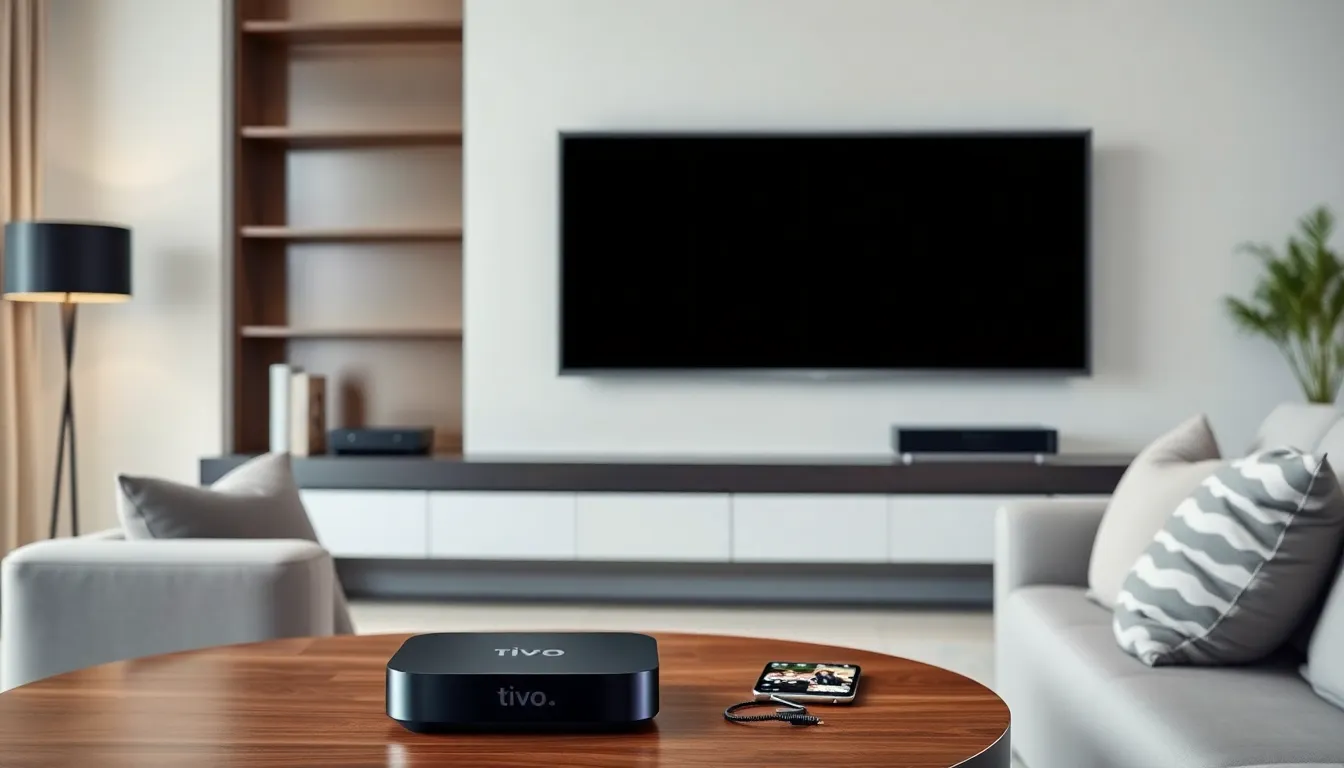Table of Contents
ToggleIn a world where binge-watching has become an Olympic sport, knowing how to record streaming TV is a game-changer. Imagine being able to pause that cliffhanger, skip the commercials, and savor every juicy plot twist at your own pace. It’s like having a remote control for time itself—minus the weird sci-fi consequences.
Understanding Streaming TV
Streaming TV provides on-demand access to a vast array of content through the internet. It allows viewers to watch shows and movies without traditional cable subscriptions, offering flexibility and convenience.
What is Streaming TV?
Streaming TV refers to delivering video content over the internet in real-time. Viewers can watch their favorite programs on various devices, including smart TVs, tablets, and smartphones. Unlike traditional broadcasting, streaming does not rely on scheduled airtimes. Instead, it offers a library of titles accessible anytime, providing the ability to binge-watch entire seasons or catch up on missed episodes.
Popular Streaming Services
Numerous streaming services populate the market, each offering unique features. Netflix delivers a rich selection of original series and films, appealing to diverse audiences. Hulu bundles current TV shows, movies, and original content, often available shortly after airing. Amazon Prime Video provides access to extensive film and TV libraries alongside rental options, enhancing the viewing experience. Disney+ focuses on family-friendly content, featuring beloved franchises like Marvel, Star Wars, and Pixar. Each service caters to specific viewer preferences, contributing to the growing phenomenon of streaming TV.
Recording Options for Streaming TV

Various recording options exist for streaming TV, ensuring that viewers never miss their favorite content. Users can choose between built-in features and external devices to suit their needs.
Built-in Recording Features
Many streaming services offer built-in recording features. Users can access cloud DVRs with platforms like Hulu and YouTube TV. These DVRs allow recording of live broadcasts, enabling users to pause or rewind shows at their convenience. Cloud storage often varies by provider, with some offering up to 1,000 hours of storage. Features usually include scheduling recordings and automatic saving of episodes. Subscribers appreciate these options, as they provide flexibility not often found with traditional TV.
External Recording Devices
External recording devices present another option for streaming TV. Hardware like the TiVo Stream 4K or HDHomeRun expands recording capabilities beyond built-in features. These devices connect to a home network, allowing users to capture live broadcasts from various streaming services. Many external options support automatic content scheduling and additional storage space. Users can often access recorded shows on multiple devices, enhancing convenience. Certain models even provide options for skipping commercials, making viewing even more enjoyable.
Using Software to Record Streaming TV
Utilizing software for recording streaming TV offers a flexible approach to capturing favorite shows. Many viewers find convenience in using specific applications tailored to this task.
Screen Recording Applications
Screen recording applications enable users to capture streaming content effortlessly. Popular options like OBS Studio and Camtasia offer customizable settings for video quality and file format. Users benefit from features such as audio capture and video editing tools within these applications. Ease of use appeals to casual viewers, while advanced settings attract tech-savvy individuals. Support for various operating systems enriches accessibility, making it easier for everyone to record and save their preferred shows.
DVR Software Solutions
DVR software solutions provide robust features for recording streaming TV. Programs like Plex and Schedules Direct incorporate Advanced Guide and recording capabilities. Users enjoy the option to schedule recordings and manage storage effectively. These solutions often boast user-friendly interfaces that streamline the recording process. Some DVR software even allows for access across multiple devices, ensuring users can watch recorded content anytime. Investing in DVR software enhances the overall viewing experience and maintains control over preferred programs.
Legal Considerations for Recording Streaming Content
Recording streaming content involves navigating several legal challenges. Understanding copyright laws and fair use guidelines is crucial for anyone who records shows.
Copyright Issues
Copyright laws protect creative works, including movies and TV shows. Unauthorized recording of streaming content typically violates these laws. Organizations such as the U.S. Copyright Office enforce these protections, making it important for viewers to respect intellectual property rights. Violations can result in legal actions against individuals. Many streaming services include clauses in their terms of service, emphasizing the consequences of illegal recordings. Users must carefully read these agreements before proceeding to record content.
Fair Use Guidelines
Fair use provides limited exceptions for using copyrighted material. Educational purposes, commentary, and criticism often qualify under this doctrine. Recording streaming content for personal use may sometimes align with fair use, but it remains a gray area. The law weighs factors such as the purpose of the use, the nature of the copyrighted work, and the effect on the market value of the original work. Engaging in non-commercial capture typically reduces the risk of infringement. Clarity in understanding fair use is vital for users wishing to balance their recording activities with legal obligations.
Recording streaming TV transforms the viewing experience by providing flexibility and control. Viewers can now enjoy their favorite shows without the constraints of traditional scheduling. With various recording options available from built-in features to external devices and software solutions, capturing content has never been easier.
Understanding the legal landscape surrounding recording is crucial for users to navigate potential copyright issues. By staying informed about fair use and copyright laws, viewers can enjoy their recorded content with peace of mind. Embracing these recording methods not only enhances the enjoyment of streaming services but also empowers users to take charge of their entertainment choices.




